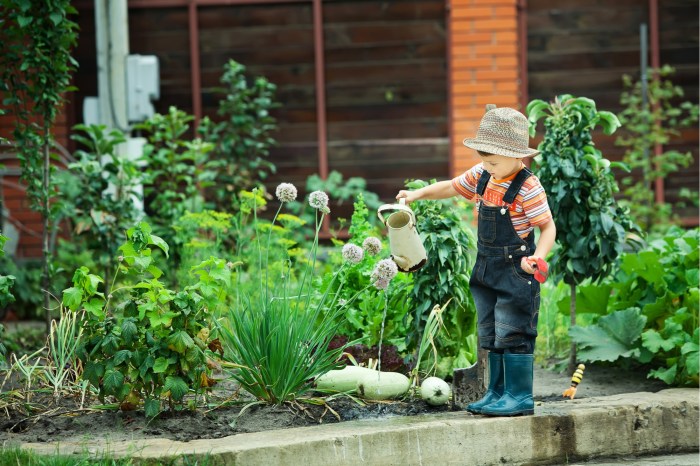Preparing the Garden for Kids: How To Grow A Garden With Kids
How to grow a garden with kids – Gardening with kids offers numerous benefits, including fostering a love for nature, promoting healthy eating habits, and teaching valuable life skills. When choosing a garden location, consider factors such as sunlight exposure, accessibility for kids, and drainage. Involving kids in soil preparation is a great way to teach them about soil composition and the importance of soil health.
Encourage them to help dig, mix compost, and add natural fertilizers.
Tips for Choosing a Suitable Garden Location
- Select a sunny spot that receives at least 6 hours of sunlight per day.
- Choose a location that is easily accessible for kids, preferably near a water source.
- Ensure the site has good drainage to prevent waterlogging.
Soil Preparation Techniques for Kids
- Start by removing any weeds or debris from the garden area.
- Dig the soil to a depth of 12-18 inches, breaking up any large clumps.
- Add compost or manure to the soil and mix it in thoroughly.
- Kids can help water the soil to settle it and promote root growth.
Selecting Plants for Kids
Selecting the right plants is crucial for a successful and enjoyable gardening experience with kids. Consider factors like plant size, color, and growth habits to ensure your little ones can actively participate and witness the wonders of nature.
Edible Plants
- Strawberries:Sweet and juicy, these low-growing plants produce abundant fruit that kids love to pick and eat.
- Tomatoes:Colorful and versatile, tomatoes can be grown in containers or the ground and are a favorite for young gardeners.
- Cucumbers:Fast-growing and easy to care for, cucumbers provide a refreshing treat for hot summer days.
Non-Edible Plants
- Sunflowers:Towering and vibrant, sunflowers add a touch of drama to the garden and attract beneficial insects.
- Marigolds:These cheerful flowers come in a variety of colors and are known for their pest-repellent properties.
- Cosmos:Delicate and airy, cosmos attract butterflies and other pollinators, creating a vibrant and lively garden.
Planting and Growing Techniques for Kids

Planting and growing a garden with kids is a rewarding experience that teaches them valuable life lessons. Here are some simple techniques to help your little ones get started.
Planting Methods for Kids, How to grow a garden with kids
There are two main planting methods for kids: direct seeding and transplanting. Direct seeding involves planting seeds directly into the soil, while transplanting involves starting seeds indoors or in a greenhouse and then moving them outdoors when they are big enough.
- Direct seeding:This is the easiest method for kids. Simply make a small hole in the soil, drop in a seed, and cover it with soil.
- Transplanting:This method is a bit more challenging, but it allows kids to get a head start on their plants. To transplant, start seeds indoors in small pots or trays. When the seedlings are a few inches tall, transplant them outdoors into the garden.
Spacing and Depth
When planting seeds or seedlings, it is important to space them properly. This will ensure that they have enough room to grow and will not compete for water and nutrients.
The spacing between plants will vary depending on the type of plant. Generally, larger plants will need more space than smaller plants. The depth at which you plant seeds or seedlings will also vary depending on the type of plant.
As a general rule, plant seeds about twice as deep as their width.
Watering and Fertilizing
Watering and fertilizing are essential for keeping your plants healthy. Kids can help with these tasks by using a watering can or hose to water the plants and by sprinkling fertilizer around the base of the plants.
- Watering:Water your plants regularly, especially during hot and dry weather. The soil should be moist but not soggy.
- Fertilizing:Fertilize your plants every few weeks with a balanced fertilizer. This will help them grow strong and healthy.
Maintaining the Garden with Kids

Maintaining a garden with kids is a great way to teach them about nature and responsibility. It can also be a lot of fun! Here are a few tips on how to make gardening with kids more enjoyable:
Weeding and Pest Control
Weeding and pest control are two important aspects of maintaining a healthy garden. Weeding helps to remove unwanted plants that can compete with your vegetables for water and nutrients. Pest control helps to protect your plants from insects and other pests that can damage them.
Here are a few tips on how to make weeding and pest control fun for kids:
- Make it a game.See who can find the most weeds or bugs.
- Use tools that are kid-friendly.There are a variety of kid-sized gardening tools available that make weeding and pest control easier for little hands.
- Make it a learning experience.Talk to your kids about why weeding and pest control are important.
Explain how weeds can compete with vegetables for water and nutrients, and how pests can damage plants.
Mulching
Mulching is a great way to improve the health of your garden soil. Mulch helps to retain moisture, suppress weeds, and regulate soil temperature. It can also add nutrients to the soil as it decomposes.
Here are a few tips on how to make mulching fun for kids:
- Let kids help you choose the mulch.There are a variety of mulches available, so let your kids help you choose one that they like.
- Make it a sensory experience.Let kids touch and feel the different types of mulch. Talk about how each type of mulch feels different.
- Make it a learning experience.Talk to your kids about the benefits of mulching.
Explain how mulch helps to retain moisture, suppress weeds, and regulate soil temperature.